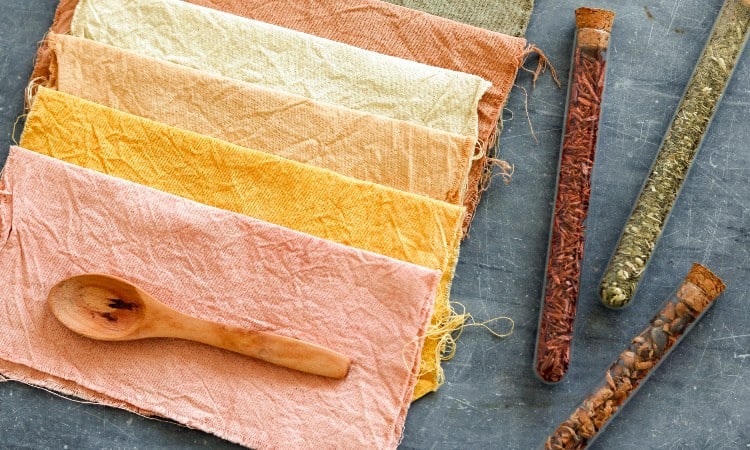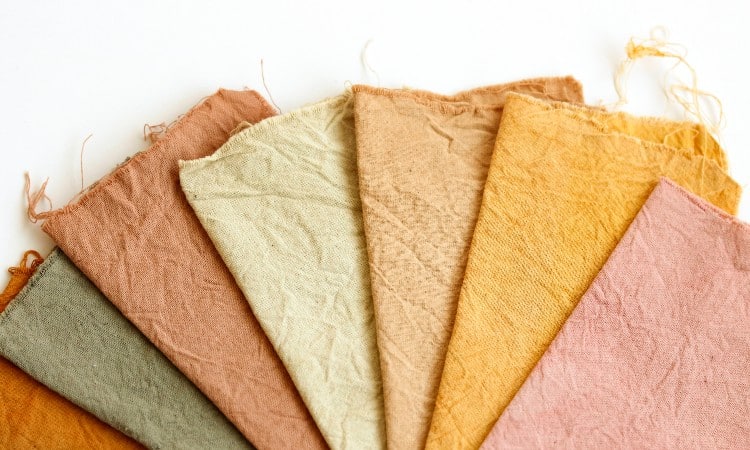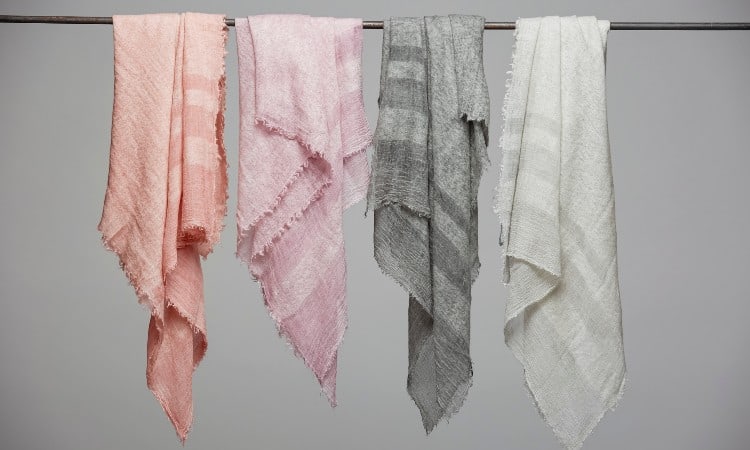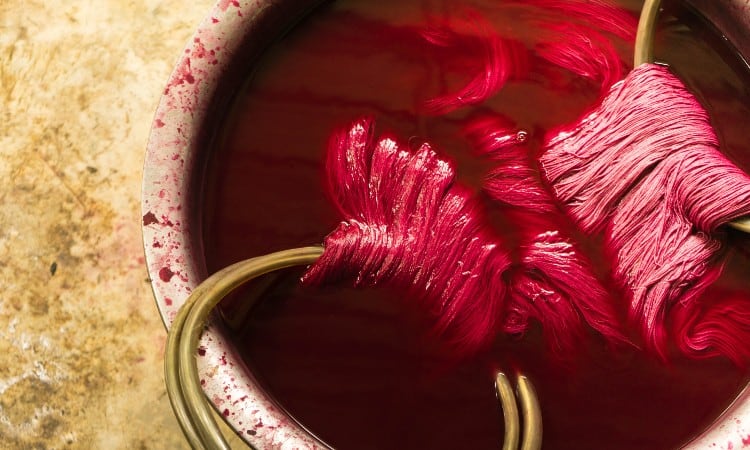Silk is one of those fabrics that has been around for centuries. Natural silk fabric is white and in the early days of using silk, it wasn’t dyed commercially. People had to dye it themselves if they wanted to change the color of it. But if you want to change the color of your fabric, how to dye silk at home?
The best way to dye silk fabric at home is:
- Choose your dye.
- Add water and dye to a pot.
- Heat the water and dye on the stove.
- Place the silk fabric in the pot.
- Allow the fabric to absorb the dye.
- Remove the fabric from the dye.
- Rinse and let dry.
Before commercial dyes were invented, silk was dyed at home using things found in nature. Commercial dyes make the process easier, but natural dyes can still be used. Here, I’ll share how to use both commercial and natural dyes to dye silk fabric at home, as well as how to remove dye from silk.

Can You Dye Silk Fabric?
The good news is that silk can be dyed at home using many different dyes and techniques. Silk holds most dye very well as long as you use the correct dye and follow the proper steps.
Although silk is considered a delicate fabric, being a natural fabric means that silk holds onto to dye very well. There are many types of dye that you can use on natural silk. This includes some of the most common types of dye: acid dye, fiber reactive dye, and natural dye.
Is It Hard To Dye Silk?
Silk is a pretty easy fabric to dye as long as you prepare the fabric properly. If you don’t take the proper steps to dye silk fabric, the fibers might not hold onto the dye as well as they should. To do this, you will need to soak the fabric in warm water to open up the fibers. Here’s how to do it.
- Fill a bucket with warm, soapy water to wash any oils or residue off of the fabric.
- Empty the bucket of water, and refill it with clean water that is about 140 degrees Fahrenheit. You can boil water if necessary to pour into the bucket, but be careful not to exceed 140 degrees because you could damage the fabric.
- Leave the fabric to soak in the water for a few hours or overnight, allowing the water to gradually cool down while the fabric is soaking.
Silk Dyeing Techniques
When it comes to dyeing silk, you can use a few techniques as far as different kinds of dye. I gave you a brief overview of some of the different categories of dye, but now let’s look at some specific examples of dye you can use for silk.
Commercial Dyes
Commercial dyes include any type of dye that is pre-packaged that you can find online or at a crafts store. Some examples include Rit Dye, Dylon Dye, food coloring, and even Kool-Aid. Most of these dyes are acid dyes, so they work well for protein fibers such as silk. The dyes are made using chemicals to color the fabric.
Natural Dyes
Natural dyes are any type of dye that you extract yourself from plants or plant materials. Pretty much any type of plant can be used as a natural dye, giving you plenty of options for the colors you can create.
Vegetables, flowers, and even coffee and tea can be used to dye silk. But just remember that some natural dyes won’t give you vivid colors like commercial dyes will, so you may have to take additional steps before dyeing.
How To Dye Silk Fabric At Home
Rit Dye
Rit Dye is one of the most popular commercial fabric dyes because it is an all-purpose dye.
That means that it will work on all types of fabric, silk included. It comes in so many colors as well.
Once you’ve chosen your color, watch this video to learn how to use it.
Note that cotton fabric is being dyed in this video, but modifications are listed for dyeing silk.
Dylon Dye
No products found.Dylon dye comes in two varieties:- Pods that you can use to dye fabrics in the washing machine
- Hand dye
You can use No products found. to dye silk, but you will need to use Dylon Hand Dye.
The washing machine variety doesn’t work well for fabrics like silk and wool.
Watch this video to learn how to use it.
Food Coloring
 Food coloring and Kool-Aid can both be used to dye protein fibers such as silk and wool. Most food coloring comes in liquid form, while Kool-Aid is essentially food coloring in powdered form. However, you’ll have a greater variety of colors to choose from if you use Kool-Aid packets instead of liquid food coloring.
Food coloring and Kool-Aid can both be used to dye protein fibers such as silk and wool. Most food coloring comes in liquid form, while Kool-Aid is essentially food coloring in powdered form. However, you’ll have a greater variety of colors to choose from if you use Kool-Aid packets instead of liquid food coloring.
Follow these steps to use food coloring or Kool-Aid to dye silk fabric:
- In a large pot, add enough water to completely cover the fabric you want to dye. Add ¼ cup of vinegar for every quart of water.
- Let the fabric soak in the mixture for about 30 minutes.
- Remove the fabric from the pot, then heat the water and vinegar mixture on the stove until it is simmering.
- If using food coloring, add a few drops at a time to the water, and mix it up. Dip a paper towel in after every few drops to test the color.
- If using Kool-Aid, empty one packet at a time of your desired color into the water and stir it until it is dissolved. Use a paper towel to test the color.
- When you’ve reached your desired color, place the fabric into the simmering water.
- Allow the fabric to soak up the dye until it is the color you want or the water turns clear.
- Turn off the heat and let the water cool to room temperature.
- Rinse the fabric under cold water until the water runs clear.
- Gently squeeze out excess water and let the fabric air dry.
How Do You Dye Silk Naturally

Natural dyes are derived most often from plant sources. The thing about natural dyes is that they can be cheaper than commercial dye. This is because you can use things you already have at home (such as flowers and leaves) or you can purchase fruits and vegetables from farmer’s markets or the grocery store.
One of the downsides to using natural dye is that you will need to mordant your clothing before using any natural dye. This is an extra step that can take some time. But it is necessary because it will help the fabric maintain the color better over time.
How To Mordant Silk
 A mordant is a chemical that is used to make dye stand out better. The problem with natural dyes is that some of the pigments produced aren’t as intense as they would be if you were using commercial dyes.
A mordant is a chemical that is used to make dye stand out better. The problem with natural dyes is that some of the pigments produced aren’t as intense as they would be if you were using commercial dyes.
You don’t have to mordant silk before you dye it. Still, mordanting is often necessary when using natural dyes to help intensify the color and help the fabric hold onto the color through repeated washes.
There are different types of mordant, but the kind that you will need for silk is known as aluminum sulfate. You will also need cream of tartar, a wash bucket, and some water. Here are the steps you should follow to mordant silk.
- Weigh your silk fabric while it is dry so that you know how much dye you will need when you eventually dye it.
- Fill a wash bucket with enough cool water to submerge the silk fabric but still allow it to move around freely.
- Place the fabric in the water and let it soak for at least an hour. Silk can take a while to become fully soaked, so leaving it in the water for an hour or two ensures that it absorbs plenty of water so that all of the fibers relax.
- After the fabric has soaked, pour the water out of the large bucket and fill a smaller container with hot water.
- Create a mixture in hot water by pouring in 1 ½ teaspoon of aluminum sulfate and 1 ½ teaspoon of cream of tartar.
- Stir the water until the aluminum sulfate and cream of tartar have been completely dissolved.
- Refill the large bucket with enough lukewarm water to submerge the silk fabric.
- Pour the mixture of aluminum sulfate and cream of tartar into the larger bucket with the lukewarm water and stir the water to evenly mix it in.
- Soak the silk in the large container overnight, stirring it occasionally to make sure that all of the fabric gets evenly covered.
- The next morning, refill the bucket with lukewarm water and gently rinse out the silk fabric.
- Lay the wet fabric out flat on a towel and roll the towel up with the fabric inside it.
- Gently squeeze out the excess water, then unroll the towel and allow the fabric to dry.
Using Different Natural Dyes To Dye Silk

Since flowers, leaves, and vegetables come in so many different colors, you can dye your silk fabric pretty much any color you want to. However, natural dyes do take a little longer to use because you have to first extract the dye from whatever type of plant you are using.
Here are some commonly used natural dyes and how to dye silk with them. Just be sure to mordant the fabric first for long-lasting color.
Coffee
Coffee is an effective way to dye silk that will result in a dark brown color. To dye silk with coffee, you will want to use instant ground coffee for the best results.
- Begin by boiling a pot of water, but make sure that you boil enough water to cover the entire fabric.
- After the water has boiled, add ½ cup of instant coffee grounds.
- Once the water has turned brown, turn off the burner so that the water is hot but no longer boiling.
- Submerge the fabric in the coffee and stir it to evenly distribute it.
- Leave the fabric in the coffee until it is the color you want it to be. The longer you leave it in there, the darker the fabric will be.
- If the water starts to get cool, you can reheat it but use tongs to remove your fabric first.
- When the fabric is as dark as you want it, carefully remove it from the water.
- Rinse the fabric under cold water until the water runs clear.
- Gently squeeze out excess water and allow the fabric to air dry.
- With subsequent washes, be sure to wash the fabric in cool water to help retain color, especially if you didn’t mordant it first.
Flowers
Dyeing silk using flowers is a great way to get some unique colors. But you will likely need many flowers to produce enough dye to dye a large piece of silk fabric. Remember that the more flowers you use, the more color your dyed fabric will have.
- After choosing the flowers, you want to use, chop the petals into smaller pieces.
- Place the chopped pieces into a pot and fill it with enough water to submerge the fabric.
- Bring the water to a boil, then reduce the heat and let it simmer for an hour.
- Strain the pot of hot water so that just the dyed water remains and not the flower petals.
- Soak the clothing in the water until it is the color that you want. You can add ¼ of vinegar to help retain the dye if you want.
- Remove the fabric, rinse it in cold water until the water runs clear, gently squeeze out the water, and allow it to air dry.
- For future washes, wash in cool water to help retain color.
Tea
Using tea to dye fabric will give it a nice light brown, beige, or taupe color. To use tea, you will first need to find a pot that is large enough to hold the fabric. Fill the pot with enough water to cover the fabric but not enough that it will boil over. Be sure to measure how many cups of water you put into the pot. You will need to use one tea bag for each cup of water.
- If your tea bags have the tags attached, cut them off before placing the tea bags into the water.
- Add the tea bags to the water with ¼ of salt.
- Bring the water to a boil. Once the water is boiling, reduce the heat to a simmer.
- Add your fabric to the water, then use tongs to move the fabric around to evenly distribute it.
- Allow the fabric to simmer in the tea for about an hour. You can leave it in there for longer if you want it to be darker.
- Once the fabric is as dark as you want it, remove it from the water. You can then soak it in clear water with about ¼ cup of vinegar for an hour to help set the dye.
- Remove the fabric and rinse it until the water runs clear, gently squeeze out excess water, and allow it to air dry.
Vegetables/Fruits
When dyeing silk, there are many different vegetables and fruits that can be used to create different colors. If you want a specific color, try one of these suggestions:
- Red- beets
- Orange- carrots
- Yellow- turmeric
- Green- spinach
- Blue- blueberries
- Purple-red cabbage
- Pink- strawberries
After you’ve decided what color you want and chosen your fruits or vegetables, you will want to chop them up very finely. Fill a large pot with water and add the chopped fruits or vegetables. Turn the heat to a simmer and let them simmer in the water for about an hour.
After an hour:
- Strain the water out into a separate pot.
- Make sure the chopped bits stay in the strainer.
- Place the silk fabric into the colored water and let it soak for at least an hour to as long as overnight, depending on how dark you want the color to be.
- Rinse the fabric under cold water until the water runs clear.
- Gently squeeze out excess water, and let the fabric air dry.
How To Dye Silk Dress, Scarves, Flowers

Dyeing a silk blouse, scarf, or dress is a fairly easy process. But the amount of time it takes depends on the size of the fabric and the type of dye you use. One of the quickest and easiest ways to do this is to use Rit or Dylon dye, following the instructions on the packaging or by watching the above videos. You can use natural dye as well, but the process will take longer and you will need to mordant the fabric first.
Dyeing Silk Flowers
Dyeing silk flowers is very easy and less time-consuming than dyeing large pieces of silk fabric. All you need is fabric dye, a bowl, and paper plates.
- Mix 1 part of your preferred fabric dye in a bowl with 1 part hot water. If using multiple colors, use a different bowl for each color.
- Take the flowers off the stems and place them in the colored dye you want to use.
- Leave the flowers in the bowl to soak up the dye for about 30 minutes or until they’re the color you want.
- Take them out of the dye and place them on a paper plate to dry.
- Once they are dry, you can reattach them to their stems.
How To Dye Silk Yarn

Acid dye is the best type of dye for dyeing silk yarn because it is quick, easy, and leaves vivid colors behind. Here’s how to do it:
- Weigh the yarn so that you know how much yarn you have. Some dyes determine how much to use based on weight.
- Fill a pot with enough warm water to cover the yarn but still allow it to move freely.
- Place the pot on the stove and heat the water using medium heat.
- Add the dye to the water-based on the amount recommended on the packaging for specific amounts of yarn or to achieve a specific color.
- Wet the yarn with warm water and place it in the pot of water.
- Gradually turn the temperature up until the water is just below boiling, stirring frequently. For silk, try not to let the water temperature exceed 185 degrees Fahrenheit.
- Add ¼ cup of vinegar for every pound of fabric. Vinegar will help the fabric hold onto the dye.
- Stir the yarn in the water for about 30 minutes.
- After 30 minutes, turn the heat off and let the water cool down to room temperature.
- Wash the yarn using Synthrapol or mild detergent and let it dry.
How To Get Dye Out Of Silk
If you mess up dyeing your silk fabric or need to strip the existing dye before dyeing it a new color, you can do this rather easily. Although bleach is very effective at removing color from fabric, you should avoid using it on silk because the chemicals found in bleach are too harsh and could damage the fabric.
 Instead, you will want to use Rit Color Remover or another type of dye removal product. To use Rit Color Remover, follow these steps:
Instead, you will want to use Rit Color Remover or another type of dye removal product. To use Rit Color Remover, follow these steps:
- Wash the fabric in warm, soapy water.
- Fill a large pot with enough water to submerge the fabric.
- Heat the water on the stove until it is simmering.
- When the water is simmering, add one packet of color remover and stir it well.
- Wet the fabric and add it to the water.
- Stir the fabric around occasionally for 10 to 20 minutes until it has lost its color.
- Rinse the fabric under running water until it runs clear. Especially for silk, start with warm water and make it gradually cooler as it rinses.
- Hand wash the fabric in warm water using mild detergent, rinse it out, and let it dry.
Conclusion
I hope this guide gave you plenty of options for dyeing silk fabric. There are many different dyes you can use, so it ultimately depends on your personal preference. Just remember to follow the instructions carefully. If you enjoyed this article, share it with others and leave a comment. Thanks for reading!